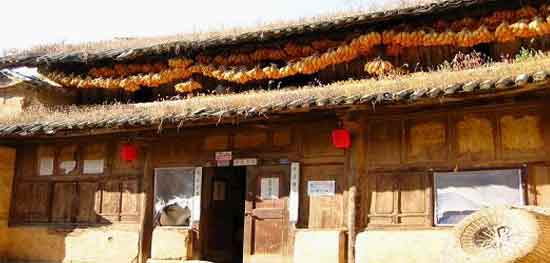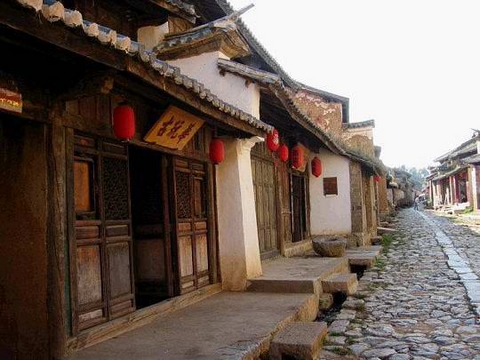
Located in Xiangyun County, Bai Autonomous Prefecture of Dali City, Yunnan Yi gets its name due to the establishment in Yunnan, Ming and Qing Dynasty; it belongs to the old haunt of Yunnan County in Han Dynasty and Yunnan Shire in Wei and Jin Dynasty. It was also a birthplace of Yunnan Province and worn the beautiful name of Hometown of Colorful Yunnan.

Yunnan Yi combined many historic relics such as classical downtown appearance, sites of Southwest Silk Road, the airport built in World WarⅡ, the airfield runway used by Flying Tiger, old sites of plane stable hole and SUA Military Headquarters, well-known Hump Air-route, Yunnan-Burma Highway, Sino-India Oil Delivery Pipe, and the ancient post road, etc. At that time, it is a place for the witness of history as well as the most important Strategic Counter-offensive Base for Allied Forces in the Fareast. For these reasons, the ancient town of Yunnan Yi was recorded into the western history.

Currently Yunnan Yi has become a beautiful place with large pieces of gleaming greens, and restored city appearance that reflects former charming. It, however, still displays the former splendid history and pursuers the glorious futures.
As the earliest place named “Yunnan” (the place to the south of the colorful cloud), Yunnanyi is the former site of “Yunnan County” of the West Han Dynasty and “Yunnan Prefecture” of the Wei and Jin Dynasties. In the Yuan, Ming and Qing Dynasties, Yizhan (remount or post stations) were set up here, so it is named “Yunnan Yi”. Due to its significant geographic location, Yunnanyi used to be contested in warfare because it can connect Dali, Chengdu, Kunming, South and West Yunnan. A time-honored ancient passage stretches through the small town with well-conserved traditional residences of the Bai ethnic minority. In the 1940s, the Yunnan-Myanmar Road, the Hump Flight, and Sino-Indian Petrol Pipe converged with the Ancient Tea-Horse Road, making Yunnanyi a place of great interest and a vital base for the Alliance to fight against the Japanese in the Orient. In Yunnanyi, there are two museums, namely the Horse Caravan Museum and the Museum for Transportation in the World War II. Besides, fighters of the Flying Tigers and the former aircraft shelters (in the farmland) are also special.
As the earliest place named “Yunnan” (the place to the south of the colorful cloud), Yunnanyi is the former site of “Yunnan County” of the West Han Dynasty and “Yunnan Prefecture” of the Wei and Jin Dynasties. In the Yuan, Ming and Qing Dynasties, Yizhan (remount or post stations) were set up here, so it is named “Yunnan Yi”. Due to its significant geographic location, Yunnanyi used to be contested in warfare because it can connect Dali, Chengdu, Kunming, South and West Yunnan. A time-honored ancient passage stretches through the small town with well-conserved traditional residences of the Bai ethnic minority. In the 1940s, the Yunnan-Myanmar Road, the Hump Flight, and Sino-Indian Petrol Pipe converged with the Ancient Tea-Horse Road, making Yunnanyi a place of great interest and a vital base for the Alliance to fight against the Japanese in the Orient.
From the second century BC to today, Yunnanyi is a military and transportation center in southwest China, ConnectingChengdu, Kunming, Tibet and Myanmar, India. Over 2100 years, Three important roads in history whichare: Wu Chi Road (Chongqing - Kunming - Yunnanyi); Ling Guan Road (Chengdu - Yunnanyi); Boonen Road (Yunnanyi - Dali - Myanmar). Tea trade was very famous. During WWII, Burma Road and the Stilwell Road (China -India) opened to traffic, Automobile replacing animaltransport. Today, horses and mules only used villagesnearby . 109 BC,Emperor Liu Che in Han Dynasty, set up Yunnan county. 225 AD, the famous prime minister, Zhuge Liang set up Yunnan state. 1274 AD, in Yuan Dynasty, Mongolia emperor Kublai Khan, set up Yunnan Province in Kunming. Since then, this place is still namedYunnan. Today, people called the village little Yunnan, In Chinese, the official inn is pronounced yi. The Official Innis named Yunnan form Yuan Dynasty, so this village is calledyunnanyi. After the Ming and Qing dynasties, and today hasmore than 600 years. Today, 4000 people are living in the oldvillage. Most of them are descendants of immigrants in early Ming Dynasty.Ancestors were employees of theofficial post office and inn.
As the earliest place named “Yunnan” (the place to the south of the colorful cloud), Yunnanyi is the former site of “Yunnan County” of the West Han Dynasty and “Yunnan Prefecture” of the Wei and Jin Dynasties. In the Yuan, Ming and Qing Dynasties, Yizhan (remount or post stations) were set up here, so it is named “Yunnan Yi”. Due to its significant geographic location, Yunnanyi used to be contested in warfare because it can connect Dali, Chengdu, Kunming, South and West Yunnan. A time-honored ancient passage stretches through the small town with well-conserved traditional residences of the Bai ethnic minority.
Traffic Route
It is at a distant of 270 km from Kunming City, 19 km from Xiangyun County. There is a branch way near banqiao toll gate of Chuxiong-Dali Expressway if you drive from Dali to Yunnan Yi, which can be reached along the east direction of 320 National Highway about 8 km away. The bus price is about 35 to 45 yuan per person from Kunming to Chuxiong.
Accommodation
residential houses in the locality, Maoyuan Hotel in Xiangyun County, Tel: 0872-3129299; Xiangyun Hotel in Xiangyun County, Tel: 0872-3121046
Special Food
steamed fish in casserole, papaya chicken, cold rice noodles with chicken thread, etc.
Near-by Scenic Spots
Damadian, Shuimushan Scenic Spot, Qinghua Cave, Jiuding Hill, etc.
Admission Fee:¥0

You will only receive emails that you permitted upon submission and your email address will never be shared with any third parties without your express permission.
